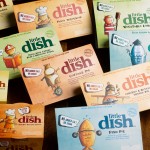How Little Dish made a big impact on kids | Case Study
Children’s meal brand Little Dish was founded to combat the glut of processed food targeting kids. Having made its mark in stores, the next step was to revamp the pack – a move that paid off, reports Philip Chadwick
The brief Founded in 2006, Little Dish is a range of meals targeting the one- to five-year-old age range with natural ingredients. Last year, the company wanted to refresh its packaging and embarked on its first major redesign in five years. The brand also rolled out a new range of pasta and sauce products targeting three- to seven-year-olds.
Client/brand Little Dish
Design B&B
UK launch date July 2012
For anyone doubting the power of packaging when it comes to selling a product, the story of children’s prepared meal company Little Dish should cast those doubts aside. Last year the brand embarked on its first pack refresh and the uplift in sales has been impressive – since the new packs hit the stores in July 2012 sales have risen by 17%.
Hillary Graves, co-founder of Little Dish, believes that the new look, along with new recipes, is central to the brand’s success and will play a part in its exciting future.
Little Dish was born in 2006 in the midst of a nutritional crisis, a crisis that continues to this day. “Traditional food companies are letting consumers down with high levels of salt and sugar in products,” says Graves. “It has a big impact on young children.”
While food firms were creating the perfect storm for obesity to flourish, there was also a gap in the market that Graves had spotted. There was no real focus on the toddlers and young children market and the options for parents were, she says, limited. The opportunity was huge – a potential £2bn market was in Little Dish’s sights.
A frenzy of market research followed, surveying mothers on what they wanted. Little Dish found that taste was the most important factor followed by sufficient nutritional information.
It came up with a range of meals that made from “100% natural ingredients” with no added salt or sugar. Little Dish aimed to be a “healthy alternative to home cooked meals” and, in 2006, went into 20 Waitrose stores and 28 Tesco outlets.
The original packaging had served Little Dish well and featured a family of animal characters. The new direction wanted to make the “ingredients the heroes” although it retains the characters including Charlie the Chicken, Trevor the Fish, Ella the Elephant and Mable the Cow.
“Kids really respond to them and we have them doing something fun from playing a sport to reading a book,” says Graves.
But there’s more to the new packs than characters. Little Dish linked up with design agency B&B to make the packs stand out on shelf with animations of the ingredients and a fun feel. The sleeve is designed to give a premium feel, moving away from the “black tray ready-meal” approach and the standout look doesn’t just end on the outside.
On the back of the sleeve is a tick-list giving the consumer a snapshot of what the product contains. There’s also a run down on the brand’s values plus all the usual heating instructions. On the reverse of the sleeve is an activity to keep youngsters busy while waiting for dinner. There’s also space to run a promotion, the most recent being Little Dish’s tie-up with Lego offering consumers a free ticket to Legoland.
Alongside the eight meals, Little Dish launched a range of fresh pasta products and sauces. Unlike the prepared meals, the new range edges the brand into a new target market – three- to seven-year-olds. The principles remain the same with the packs incorporating a simple background, strong product visibility, a story book look and the range of characters embarking on a raft of activities.
The new packs and product lines went into stores last July and the results have been strong. An eye-catching 17% uplift in sales is encouraging as is the brand’s listing in all Waitrose stores, 800 Tesco stores as well as going into Asda and Morrisons. And the Little Dish brand hasn’t just limited itself to meals – there’s now a Little Dish Cook Book by Graves, compiling over 60 recipes. It’s also been active on social media sites such as Facebook and Twitter. Little Dish has also found its meals are being enjoyed by a market it never intended to target – pensioners.
Little Dish is hoping to keep the momentum of the brand going. And its success, past present and future, is thanks, in no small part, to the packaging


































